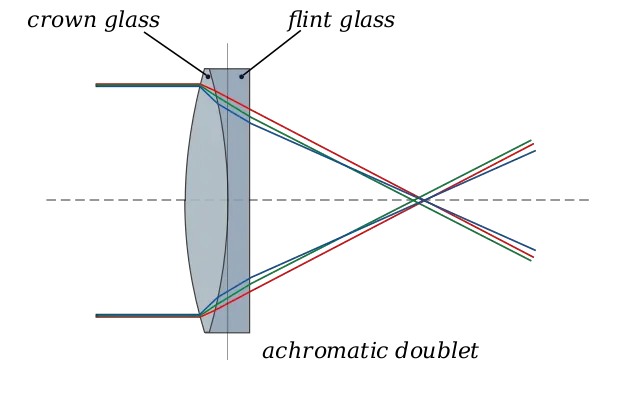If you’re new to astronomy, you might be wondering about the difference between apochromatic and achromatic refractors. Don’t worry. The lingo about ‘APO’ and then doublet vs triplet confused me too. What did it all mean? So I did some research and put this together.

Achromatic refractors are generally more affordable and for that reason considered a feasible option if you’re just starting out in astronomy. But here’s what else you need to know…
Apart from the cost, the main difference between apochromatic and achromatic lenses has to do with how well they correct for chromatic aberration. The main thing that tells us is that if you intend to tinker with astrophotography, you’ll want the apochromatic telescope versus the achromatic option.
Achromatic Refractor
(Doublet)
Pros
Terrestrial/night sky observing
Relatively inexpensive
Cons
Not very good for photography
Usually less compact than a similar diameter apochromatic refractor
Apochromatic Refractor
(Triplet)
Terrestrial/night sky observing
Excellent for photography
Usually more compact than a similar diameter achromatic refractor
Excellent for photography
What you get with chromatic aberration is color fringing or blurring in the final image you see through your telescope. It’s a problem associated with lenses, which refractor telescopes use as opposed to reflectors, which use mirrors. Refractors also suffer from astigmatism, another type of aberration.
So you know, a refractor telescope objective with three elements is often called a triplet whereas one with two elements is a doublet.
Explaining achromatic
In the word “achromatic,” the prefix “a-” means “without” or “not.” Therefore, “achromatic” means “without color” or “not having any hue.” The term is often used to refer to lenses or other optical devices that are designed to transmit light without separating it into different colors.
Achromatic lenses or doublets are used in many different applications, including photography, microscopy, and astronomy, where the elimination of color distortion is important for obtaining clear and accurate images. Overall, the prefix “a-” is a commonly used word element in English that negates or reverses the meaning of the word it is attached to.

Achromatic lenses use two different types of glass with different refractive indexes to bring two frequencies of light (typically red and blue) into focus at the same point. The two types of glass typically used are Schott borosilicate Crown glass and flint glass. Crown glass has a lower refractive index than flint glass, which means that it bends light less than flint glass does. This property makes Crown glass ideal for the convex (or outward-curved) part of an achromatic lens.
Achromatic lenses were first developed in the early 18th century by Chester Moore Hall, an English barrister and amateur optician. His innovation paved the way for the development of the modern refracting telescope.
Doublet “apo” refractors
There are higher-quality achromatic refractors, referred to as doublet “apo” refractors. These use ED glass or fluorite in a doublet objective to further reduce chromatic aberration without the need for three lenses (as in the true APOs).
While they are not as well-corrected as a proper apochromatic refractor, these telescopes offer a big improvement over the standard achromatic scope for a price lower than a typical apochromatic (see chart at end).
It’s worth noting that even the less expensive models are significantly better than standard achromats. Despite technically being only advanced achromats, they are almost always called “apo” refractors. The quality of these telescopes varies, but the best are almost every bit as good as a true apochromat.
Explaining apochromatic (APO)
The prefix “apo-” in apochromatic is derived from the Greek word “apó,” which means “away from” or “separate.” In optics, this prefix is used to describe a type of lens that is designed to minimize chromatic aberration, which is an optical distortion that causes different wavelengths of light to focus at different points.
Apochromatic lenses are made with specialized glass materials that allow them to focus all colors of light on the same focal plane, resulting in sharper and clearer images. Therefore, the term “apochromatic” refers to a lens that is free from chromatic aberration, or “separated from” this type of optical distortion.

Apochromatic lenses combine three lens elements of different types of glass, each with a different refractive index. By carefully selecting and arranging these elements, apochromatic lenses can bring three different wavelengths of light (red, green, and blue) into focus at the same point, resulting in sharper and more accurate images with little or no color fringing.
There are typically three types of glass associated with apochromatic lenses: Crown glass, Flint glass, and Extra-low dispersion (ED) glass.
Crown glass with its low refractive index is typically used for the convex elements in apochromatic lenses, similar to the achromatics. Flint glass with a higher refractive index is used for the concave elements.
Extra-low dispersion (ED) glass is typically incorporated to further reduce chromatic aberration. It is made by adding small amounts of rare earth metals to the glass, which helps to disperse the light more effectively and produce clearer, more accurate images.
Apochromatic lenses were developed in the 19th century, later than the achromatic lens type. The credit usually goes to the German optician and physicist Ernst Abbe, who worked for the Carl Zeiss company for this adaptation. The design allowed for much greater color accuracy and image sharpness, particularly in high-magnification applications such as microscopy.
Comparing achromatic vs. Apochromatic refractors by price
| Choices | Aperture | Mount | Price |
|---|---|---|---|
| Good starter achromatic scope | 70-90 mm | Small Equatorial | $200–300 |
| Automated achromatic | Goto | $300-400 | |
| High-quality “apo” doublets | 80-100 mm | Equatorial | < $1000 |
| Best “apo” doublets | 100 mm | > $2000 | |
| True apochromatic triplets | 80-100 mm | < $1000 | |
| Best apochromatic triplets | > $1000/inch | ||
| High-quality 10″ refractor | 250 mm | > $10,000 |
